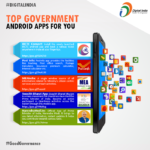IDC, that is, International Data Corporation has revealed a few statistics recently talking about the growth of technology in the future. One of these statistics is showing the market share of Android OS in the coming future.
At present, around 76% of the market share is captured by Android OS. IDC estimates this share to increase by 87% in 2022. Needless to say, this OS is going to keep dominating the global market.
It has been over a decade that Android is introduced by Google, and since then this operating System has brought many upgrades and versions in the market, the latest being Android 10.
Considering its growth, this Operating System is going to go a long way. Here is an attempt to shed some light on the hot and top android app development trends which would rule 2020.
Continued Rise of Android Instant Apps
Here is the trend, skipping the boring process of ‘Installation’ and allowing users to enjoy apps simply by tapping on them. This is made possible by Google Play Instant, where users no more have to download apps and they can use them directly from the cloud (more like using a website). Not having to download an app, saves users’ mobile space and time. Google has already taken a few baby steps towards this fantastic trend by introducing some new features for Android app developers, allowing them to build android mobile apps which can be downloaded easily, without having to install them. Check out more about Android App Bundle to understand this trend better.
Android Enterprise
Here is the solution brought by Google to help business organizations in managing their data without having to lose control over the apps. Android Enterprise facilitates and healthy eco-system for android apps.
Android Enterprise comes with APIs along with other tools that provide developers with integrated support for Android into EMM, which is enterprise mobility management (EMM).
Android Enterprise Use Cases:
Employee Owned Devices or Bring Your Own Device.
Organization Owned Devices for Common Use
Organization Owned Devices for Specific Devices
Apps are Getting Smarter
Advanced technologies such as Artificial Intelligence, Machine Learning, Virtual Reality, Augmented Reality, etc. are gradually making a very emphasized change in the ways Android OS is being used. These technologies have the potential to do even bigger things. With AI integrated with Android, smartphone users or mobile devices users can enjoy features like barcode reading, landmark/text/graphic recognition, etc. With AI, one can get updates about the nearby location, for example, traffic jams on the nearby street, calamities, etc. With AI integrated Android apps, users will be served better with a more customized approach.
Features like Image Labelling can help android developers in building a more interactive user experience by making users feel more attached to the image/graphic/object.
Just like AI, Machine Learning (ML) is upgrading Android apps by enabling them to learn from experience without being programmed or ordered to do so.
Beacon Technology
Have you heard of this emerging trend? Let us understand it in the easiest way possible. Suppose you have an android app selling your products, along with the experience store. Suppose the user of your app is around one of your experience stores, the user will be notified about the presence of the store through Beacon Technology.
Beacon Technology is a Bluetooth technology integrated with wireless transmitters to send signals. If incorporated with the Internet of Things, this trend will do some amazing jobs for retailers, services/product vendors, etc.
Accelerated Mobile Pages (AMP)
One of the key factors impacting-attracting-connecting & engaging every online content consumer is the loading time of the webpage/website/blog. Lesser the loading time, the better the user experience. Hence, to provide users with better experience through increase the mobile page loading time, Google and Twitter have collaboratively introduced AMP. Accelerated mobile pages also reduce the bounce rate.
Android Jetpack
Android Jetpack is a bunch of guidelines, tools, and libraries, build to help developers in creating better Android apps. All the components of Jetpack are based on modern app development practices like testability, separation of concern, Kotlin Integration, etc. Though the component s in Jetpack are built together, developers are free to use any component they want depending upon their requirements. Jetpack allows android developers to build strong apps with less code.
All the components in Android Jetpack are categorized in four ways:
- Architecture,
- Foundation,
- UI, &
- Behavior
What Else?
Android Jetpack provides developers with some more components, here are they:
- WorkManager
- Navigation
- Paging
- Slices
Conclusion
The data mentioned above help you understand how this new year is going to impact the ways we use the Android operating system and devices run on it. With Android advancements, things are sure to get better, faster, safer and easier to use.
These Android trends are undoubtedly going to impact the Android App Development Industry too. Google is not going to disappoint its huge user base, and is going to come up with better user experience and make it even more interactive and smarter for its global users.
Though trends come and go often, it is vital to know the latest technology updates to have a competitive advantage.
Related Posts












